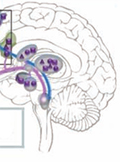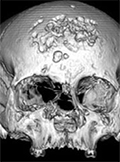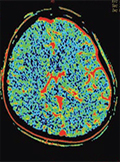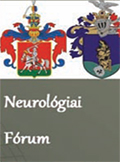The eLitMed.hu medical portal uses computer cookies for convenient operation. Detailed information can be found in the Cookie-policy.
Clinical Neuroscience - 2016;69(03-04)
Content
[Hungarian adaptation of a short eating disorder questionnaire (SCOFF)]
[Aim - Eating disorders are becoming an increasingly relevant health issue, therefore the fast and accurate screening of people at risk is of great practical importance. The aim of SCOFF questionnaire is to assess this risk and the extent to which a person is affected, by using five simple yes or no questions. The objective of our study was to assess the validity of the Hungarian version of the test Methods - 777 medical students (210 men, 567 women, mean age 22.3±2.33 years) participated in the survey. The online questionnaire contained anthropometric data, the Eating Behaviour Severity Scale and, beside the SCOFF, the Eating Disorder Inventory (EDI). Results - The SCOFF is excellent at screening clinical eating disorders. Its sensitivity was 100% and specificity 85.1%. It is less efficient at detecting subclinical cases, but it does not show worse results than EDI. According to the data SCOFF is better at identifying more serious cases. Applying on the same sample SCOFF had higher sensitivity and lower specificity than EDI. Discussion - SCOFF is suitable for primary screening of eating disorders with a non-diagnostic purpose, taken two “yes” answers out of five as the critical margin, specified by the authors.]
Cerebral amyloid angiopathy related inflammation: is susceptibility weighted imaging the clue for diagnosis?
Background - Cerebral amyloid angiopathy-related inflammation (CAA-ri) is characterized by various neurological symptoms such as gradually developing confusion, progressive cognitive decline, seizure or headaches; T2 hyperintensities on magnetic resonance imaging (MRI); and neuropathological evidence of cerebral amyloid angiopathy (CAA) and associated vascular or perivascular inflammation. Although histological confirmation is necessary for accurate diagnosis, in case of typical clinical features and neuroimaging, the diagnosis can be established without biopsy. Case summary - We present the case of a 57-year-old man with a history of hypertension who presented to the emer¬gency department 3-week history of progressive headache and a gradually developing altered mental status. On examination, he was found to have left sided weakness and decreased pscyhomotility. Routine clinical work-up (lab investigations, CT, cerebrospinal fluid analysis) did not show obvious diagnosis, so we performed an MRI. It raised the suspicion of CAA-ri which diagnosis was verified by neuroradiological evaluation. High dose steroid treatment was initiated. The patient rapidly responded to treatment, his focal neurological signs resolved. Control MRI after 1.5 months showed multiple haemorrhagic laesions in the field of previous inflammation which posteriorly supported the previous supposed work-diagnosis. Conclusions - Although histopathology is the gold standard for the diagnosis of cerebral amyloid angiopathy, the typical clinical presentation, good response to steroids and accurate neuroradiological criteria make biopsy unnecessary to diagnose CAA-ri.
The electrophysiological changes after 1 hz RTMS in ALS patients. A pilot study
Motor neuron diseases are disabling poor prognostic conditions, with no successful treatment. Repetitive transcranial magnetic stimulation might offer a temporary functional improvement. Objective - We intended to evaluate the extent of the functional improvement using electrophysiological and clinical tests. Methods - Patients with motor neuron disease (amyotrophic lateral sclerosis) were included. Muscle strength and respiratory function assessment represents the clinical approach, and central motor conduction time, motor unit number estimation, blink reflex and H-reflex stands for electrophysiology. Two tests were performed using the whole battery prior and after low frequency repetitive transcranial magnetic stimulation, using 1 Hz stimulation frequency for five consecutive days, 20 minutes daily, at 80% of the individual resting motor threshold. Results - Central motor conduction time, muscle strength and pulmonary function showed no statistically significant differences, but a tendency towards improvement. Motor unit number estimation, blink reflex and H-reflex showed a significantly better outcome after the five day repetitive transcranial magnetic stimulation treatment. Conclusion - Low frequency repetitive transcranial magnetic stimulation influences beneficially electrophysiological parameters in amyotrophic lateral sclerosis, but with little clinical impact; further studies are needed to validate the extent of the effect.
[The importance of anticoagulant therapy in patients with artial fibrillation in stroke prevention – summary of international data and novel therapeutic modalities]
[The most common cardiogenic cause of ischaemic stroke is atrial fibrillation which increases the probability of stroke five-fold and doubles case fatality. Based on international data the incidence of atrial fibrillation is approx. 2% however this rapidly increases with age. The necessity of using oral anticoagulants in the prevention of non-valvular atrial fibrillation related stroke is decided based on estimated stroke risk. The CHADS2 and the more predictive CHA2DS2-VASc scales are used for this purpose while the bleeding risk of patients treated with anticoagulant may be estimated by the HAS-BLED scoring scale. For decades oral anticoagulation meant using vitamin-K antagonists. Based on international data we can see that rate of anticoagulation is unacceptably low, furthermore most of the anticoagulated patients aren’t within the therapeutic range of INR (INR: 2-3). A lot of disadvantages of vitamin-K antagonists are known (e.g. food-drug interaction, need for regular coagulation monitoring, increased risk of bleeding), therefore compounds with new therapeutic target have been developed. The novel oral anticoagulants (NOAC) can be divided in two major subgroups: direct thrombin inhibitors (dabigatran etexilate) and Xa-factor inhibitors (rivaroxaban, apixaban, edoxaban). These products are administered in fix doses, they less frequently interact with other medications or food, and regular coagulation monitoring is not needed when using these drugs. Moreover several studies have shown that they are at least as effective in the prevention of ischaemic stroke than the vitamin-K antagonists, with no more haemorrhagic complications.]
[The therapeutic use of transcranial magnetic stimulation in major depression]
[The antidepressive effect of repetitive transcranial magnetic stimulation (rTMS) has been investigated for almost 20 years now. Several studies have been published aiming to identify the exact and reliable parameters leading to the desired therapeutic effect. However, the related literature shows great variability. The current overview aims to provide a comprehensive overview of factors associated with the therapeutic effect of rTMS in major depression. High frequency stimulation of the left dorsolateral prefrontal cortex (DLPFC) for 3-6 weeks leads to mood improvement comparable to the effect of antidepressive medications in 35-40% of patients. Pharmacotherapy resistant patients treated with rTMS reach remission for 3 months on average. Low frequency stimulation of the right DLPFC appears to be similarly effective, though much less investigated so far. In addition to the exact delineation of the stimulation area, treatment outcome is also related to stimulation intensity as well as the number of sessions and impulses. Considering the safety and tolerability aspects of rTMS, it might be a significant therapeutic support for therapy resistant patients. Above this, patients diagnosed with major depression might benefit from the additional positive influence of rTMS improving the effect of antidepressive medication. Based on converging research evidence, the Food and Drug Administration (FDA) agency approved the use of rTMS as a treatment option for therapy resistant major depression in 2008. So far, in Hungary rTMS is primarily considered as a promising tool in research settings only. Hopefully, patients suffering from major depression will increasingly benefit from the positive therapeutic effect of this intervention.]
Hungarian experiences with the Beliefs About Attractiveness Scale
Background and purpose - Sociocultural influences regarding bodily appearance and their psychological consequences play a considerable role in the development and maintenance of body image disturbance and eating disorders. The purpose of the study was to explore the psychometric properties of the Beliefs About Attractiveness Scale-Revised and its correlates among young adults in Hungary. Methods - In our cross-sectional online study, participants were 18-35 years old (N=820, 40% male). Measures: self-reported anthropometric data, Beliefs About Attractiveness Scale-Revised, Eating Disorder Inventory, SCOFF questionnaire, Sociocultural Attitudes Towards Appearance Questionnaire-3, and Rosenberg Self-esteem Scale. Results - The exploratory factor analysis showed that the fit indices of the three-factor solution are acceptable (c2(171)=5124.8, p<0.001, CFI=0.944, TLI=0.918, RMSEA=0.054, SRMR=0.030). Along the original ‘Importance of being thin’ and the ‘Importance of being fit’ factors, a third factor emerged, namely the ’Life fulfilment aspect of attractiveness’ factor. Internal consistency and construct validity of the scales were confirmed. Among those who were at risk of developing an eating disorder, all of the measured beliefs were significantly greater than among those who were not at risk (thin: Z=6.501, p<0.001, Cohen’s d=0.63, fit: t(818)=-4.749, p<0.001, Cohen’s d=0.41, and life fulfilment: t(239)=-5.702, p<0.001, Cohen’s d=0.53). Conclusion - The Hungarian version of the Beliefs About Attractiveness Scale-Revised is a reliable, valid measure and we suggest its introduction into Hungarian research. Relationships between beliefs about attractiveness and self-esteem, body image and eating disorders suggest intervention opportunities in with regards to prevention and treatment of eating disorders.
[Individual evaluation of loreta abnormalities in idiopathic generalized epilepsy]
[Background – Contemporary neuroimaging methods disclosed structural and functional cerebral abnormalities in idiopathic generalized epilepsies (IGEs). However, individual electrical (EEG) abnormalities have not been evaluated yet in IGE patients. IGE patients were investigated in the drug-free condition and after 3-6 month of antiepileptic treatment. To estimate the reproducibility of qEEG variables a retrospective recruited cohort of IGE patients was investigated. 19- channel resting state EEG activity was recorded. For each patient a total of 2 minutes EEG activity was analyzed by LORETA (Low Resolution Electromagnetic Tomography). Raw LORETA values were Z-transformed and projected to a MRI template. Z-values outside within the [+] 1. In drug-free condition, 41-50% of IGE patients showed abnormal LORETA values. 2. Abnormal LORETA findings showed great inter-individual variability. 3. Most abnormal LORETA-findings were symmetrical. 4. Most maximum Z-values were localized to frontal or temporal cortex. 5. Succesfull treatment was mostly coupled with disappearence of LORETA-abnormality, persistent seizures were accompanied by persistent LORETA abnormality. 1. LORETA abnormalities detected in the untreated condition reflect seizure-generating property of the cortex in IGE patients. 2. Maximum LORETA-Z abnormalities were topographically congruent with structural abnormalities reported by other research groups. 3. LORETA might help to investigate drug effects at the whole-brain level.]
[Computed tomographic examination of cranial lesions, a paleoradiological approach]
[Background and purpose - Introducing the multidisciplinary paleoradiology research at the Institute of Diagnostic Imaging and Radiation Oncology of the Kaposvár University, highlighting the cases with potential central nervous system involvement - from the scanning methods to the 3D printing - in order to draw attention to the historical background and clinical aspects of certain pathological conditions. Methods - The authors developed the examination protocols for three different CT scanners. Among the examined archaeological remains cranial lesions were identified in 26 cases, from which 4 cases with potential central nervous system involvement are demonstrated. The scanning parameters and the advantages of secondary image reconstructions (multiplanar reconstruction, maximum intensity projection, three-dimensional volume rendering technique) are presented with the cases. Results - The authors demonstrate a case with destructive skull lesions due to syphilis from the 15th century AD, a condition rarely seen or even unknown nowadays in the modern world. With the CT images of the skull base fracture from the Iron Age, signs of healing could be verified. Using the CT images a non-invasive approach is presented in the case of the craniofacial osteosarcoma in order to visualize the local status and the direct intracranial propagation. Advantages of the 3D VRT reconstructions are shown in the case of unilateral coronal suture synostosis. Conclusion - Paleoradiological CT examinations serve as a non-invasive, non-destructive tool for studying archaeological remains and artifacts. The special applications provided by the imaging modality contribute to the conventional paleopathological investigations. Keywords: paleoradiology, computed tomography, 3D reconstruction, skull lesions, paleopathology]
[Systemic thrombolysis and endovascular intervention in postpartum stroke]
[Introduction - There are no previously published cases about intravenously applied recombinant tissue plasminogen activator in acute ischemic stroke during puerperium. Case presentation - We report a 40-year-old woman with postpartum acute ischemic stroke caused by multiple cervical artery dissections treated by systemic thrombolysis and endovascular intervention. Discussion - There are only limited data regarding thrombolytic treatment in acute stroke during pregnancy and puerperium. Current acute stroke treatment guidelines - while considering pregnancy as a relative exclusion criterion - do not deal with the postpartum state. Conclusion - As the condition is rare, randomized controlled trials are not feasible, therefore further reports on similar cases could eventually help us suggest guidelines or at least propose recommendations for the acute thrombolytic treatment of strokes occurring in pregnancy and puerperium.]
[Endoscopic removal of tuberculum sellae meningeoma through endonasal transsphenoidal approach]
[Experiences acquired in our department with endoscope assisted microsurgical transsphenoidal pituitary surgery encouraged us to expanded the endoscopic approach to skull base lesions. The endoscopic endonasal transsphenoidal approach proved to be less traumatic to the traditional microsurgical approaches, yet very effective. The endoscopic transsphenoidal technique was applied in a patient havin anterior skull base tumor. The patient was a 49-year-old woman with several months history of left visual defect. The magnetic resonance (MR) scans of the skull revealed a midline anterior fossa space-occupying lesion measuring 21×16×22 mm located on planum sphenoidale, tuberculum sellae and intrasellar. The tumor compressed both optic nerves and optic chiasm. Total resection of the tumor was achieved by use of endoscopic transnasal, transsphenoidal technique. This is the first reported case of an anterior fossa meningeoma being treated by an endoscopic transsphenoidal technique in Hungary.]
[Antecedents to the commencement and history of the West- Pannonic neurological forum]
[Introduction - Numerous professional groups and sections for the medical specialities have been organized since 1953 in the West-Transdanubian region of Hungary, but such association of neurologists had not occured. Establishing the West-Pannonic Neurological Forum - The lack of regional collaboration among neurologists was related to several factors, among which the most important factor was the lack of a regional medical university, which could coordinate the professional activities. This severe gap necessitated in 1998 the organization of a professional group, that has become a driver for case-consulting conferences and different postgraduate trainings for the physicians specialized in neurology, neurosurgery and neurorehabilitation in counties of Győr-Moson-Sopron, Vas, Veszprém and Zala. The functioning of the Forum - Meetings are organized twice a year for physicians and paramedical staff (nurses, hospital attendants, physiotherapists) on Thursdays afternoons in different towns of the region, in two sections. The lectures are followed by a buffet, after which everyone can get home before too late. Ocasionally guest-lecturers are invited to present scientific topics from Hungarian universities or abroad. However, the main form of the presentations is defined as case discussion. Conclusions - The numbers of platform and other presentations in the physicians’s section have exceeded half a thousand, while in the paramedical section reached the threehundreds. At the 38. meeting of the Forum in January of this year, the number of participants was more than twohundreds, reflecting that both physicians and their coworkers are greatly interested in this form of interactions.]
1.
Clinical Neuroscience
[Headache registry in Szeged: Experiences regarding to migraine patients]2.
Clinical Neuroscience
[The new target population of stroke awareness campaign: Kindergarten students ]3.
Clinical Neuroscience
Is there any difference in mortality rates of atrial fibrillation detected before or after ischemic stroke?4.
Clinical Neuroscience
Factors influencing the level of stigma in Parkinson’s disease in western Turkey5.
Clinical Neuroscience
[The effects of demographic and clinical factors on the severity of poststroke aphasia]1.
2.
Clinical Oncology
[Pancreatic cancer: ESMO Clinical Practice Guideline for diagnosis, treatment and follow-up]3.
Clinical Oncology
[Pharmacovigilance landscape – Lessons from the past and opportunities for future]4.
5.














